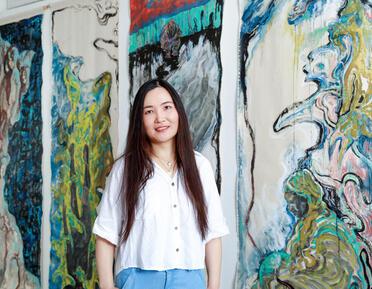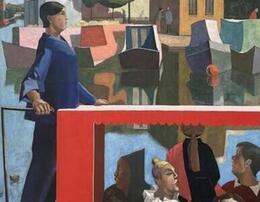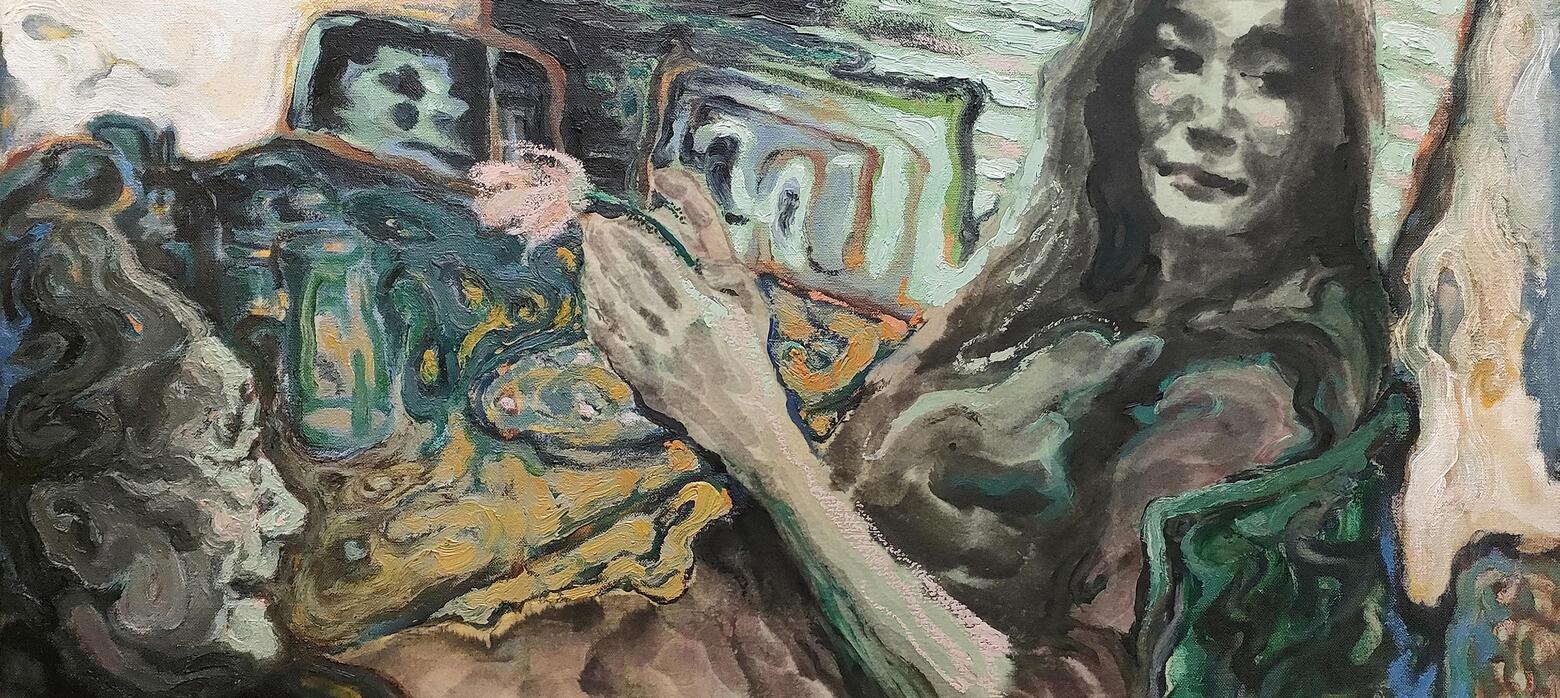Beyond the Prize: Stories of Creativity
Beyond the Prize is a new exhibition, presented by the Federation of British Artists at Mall Galleries, featuring recent award-winning artists of FBA Society exhibitions. It is through the initiatives of the Federation that more than £100,000 worth of prizes, bursaries, residencies and scholarships are awarded to artists annually.
Bringing together the best emerging and established artists from art societies across the UK, the exhibition celebrates the impact of prizes and awards on their work, and their work on the world. For many, this is a turning point in their practice, both professionally and creatively.
Read on to hear about the journeys of creativity and practice development winning a prize has led our artists on.
Yin Wang

Yin Wang won the Winsor & Newton Painting Award at the Royal Society of British Artists Annual Exhibition.
How would you describe your work in the show?
My work, A Home That Holds Me, A Screen That Sees Me, explores themes of distance, memory, and presence through the lens of surveillance and family connections. Inspired by a CCTV still from my grandparents' home in China, my work reflects the surreal experience of seeing myself on the screen—transforming from an observer, viewing from afar in the UK, to a subject within the frame. The contrast between belonging and transience is central to this piece; the surroundings and my grandfather are rendered in thick oil paint, evoking permanence and stability, while my own figure is painted on delicate rice paper, symbolising a drifting, ghost-like presence—a visitor in a familiar space.
Please describe your working process. Has this changed over time?
My work often begins with collecting images and information that reflect hotspots and social realities, drawn exclusively from Chinese social media, the Chinese search engine Baidu, or from personal recollections. These sources often capture moments of emotional or psychological tension or highlight topics I feel compelled to raise awareness about. This selective process allows me to engage with both collective and personal memory, grounding my work in a specific cultural and emotional context. In this particular piece, I started with a CCTV still that captured the strange feeling of seeing myself within the context of my grandparents' home. I used oil paint for the background and my grandpa, representing solidity and permanence, while rice paper serves to depict my figure—fragile and transient.
This mixed-media approach began last year; before that, I worked in a single medium. Since then, I’ve been exploring the combination of rice paper and oil—layering the solidity of oil on canvas with the delicate, drifting quality of ink on rice paper—to reflect either the tension between textures or a dreamlike quality. This shift has opened up new creative possibilities and I’m still refining how these contrasts come together.
Winning the Winsor & Newton Painting Award [...] was a huge surprise and a turning point for my practice.
How has winning an award impacted you / your practice?
Winning the Winsor & Newton Painting Award at the Royal Society of British Artists Annual Exhibition last year was a huge surprise and a turning point for my practice. It was the first time I had exhibited a piece that combined rice paper and canvas in a simple minimalist way—using only black ink and the natural tone of the unprimed canvas. The recognition affirmed my creative instincts, strengthened my commitment to working with mixed media and pushed me to further explore how materials and textures can communicate emotional and conceptual depth.
The exhibition opening is on World Art Day (15 April). What impact do you think art has on the world, now, and in the future?
Art has the power to act as both a mirror and a catalyst for change. In a time when global challenges—such as displacement, identity struggles, and the tension between tradition and modernity—are increasingly amplified, art provides a space to reflect on personal and collective histories while imagining new possibilities. As technology advances and our lives become more interconnected yet isolating, art offers a counterbalance—a space to slow down, feel, and connect on a deeper, human level. It reminds us that, even amidst the omnipresence of screens and surveillance, there is still room for vulnerability, impermanence, and the quiet beauty of being truly seen. In the future, I believe art will continue to drive social change, challenge perceptions, and foster cross-cultural understanding, helping us navigate the complexities of an ever-evolving world.
Ronald Hellen
Ronald Hellen won the Dry Red Press Award at the New English Art Club Annual Exhibition.
How would you describe your work in the show?
My painting in the show, Boarded Tower and Power Stations, Dungeness, reflects my work as a realist painter. My paintings evolve from drawings and close observation of places and locations often of an unusual or quirky nature. In this painting, therefore, the brooding presence of the huge power stations appears in stark contrast to the apparent fragility of the ancient boarded signal tower on the shingle banks at Dungeness.
Please describe your working process. Has this changed over time?
My initial response to a location or landscape is to produce a number of drawings of the scene. The more drawings and from as many viewpoints as possible the better, so that I have a firm grasp of the salient features. This helps me to discard what I consider unhelpful to the composition and to emphasise that which I think important. Photographs I find of limited use only. My working process has remained relatively unchanged over time.
The award has given me the confidence to approach new subjects and to develop the illustrative aspects of my practice.
How has winning an award impacted you / your practice?
Winning the Dry Red Press Award has given me the opportunity to work with the Dry Red Press team and to see how my work lends itself to reproduction in a printed format. The Dry Red Press greetings card of my painting has enabled my work to reach new audiences and raised my artistic profile. The award has given me the confidence to approach new subjects and to develop the illustrative aspects of my practice as a result. I am very grateful to Dry Red Press for their support of my work and the new opportunities that their award has provided.
The exhibition opening is on World Art Day (15 April). What impact do you think art has on the world, now, and in the future?
Art continues to have an impact on the world both now and in the future because art is a universal language that can provide meaning for everyone, transcending barriers and cultures in a way that other forms of communication cannot. Art provides a reflection of society through the unique perspective of the artist and because art can mean so many things – from video, happenings, photography, light and sound to traditional painting – the nature of art is as endless and as varied as the artist driven to produce it.
Miranda Brookes
Miranda Brookes won both the Michael Harding Award and the John Purcell Paper Prize at the Royal Institute of Painters in Water Colours Annual Exhibition.
How would you describe your work in the show?
The paintings are both based on Charnwood Forest in Leicestershire and use a range of watercolour techniques and materials. The works try to capture the essence of the place which is a managed woodland of mainly native trees.
Please describe your working process. Has this changed over time?
I paint using various watercolour techniques including layers often comprising foreground, middle distance and background. These layers harden and are then manipulated including through wetting, scratching and sanding to change or reveal the layer below or the watercolour paper itself. The fine details of small shrubs, buds, seed heads, leaves, brambles and branches are often revealed through painting the negative shapes, the spaces between the shrubs, rather than the shrubs themselves.
My range of watercolour techniques has changed over time as I have experimented with different approaches and materials to achieve my interpretation of the landscape. This has been significantly enhanced through learning about the history of watercolour and art in general. In April 2021, during the pandemic, I participated in an inspiring online course, Watercolour: J.M.W. Turner’s Theory and Practice at the Courtauld with Nicola Morby. This course gave me access to a deeper and wider understanding of Turner’s work and watercolour in general. It is this understanding that I have been applying to my practice.
It has led me to develop a new palette using colours I would not have chosen that mix to reveal a subtle and extensive range of vivid and intense tints.
How has winning an award impacted you / your practice?
Winning the Michael Harding Award and John Purcell Paper Prize has had a very significant impact on my practice. The awards increased my confidence as a painter. In addition, they encouraged and gave me the freedom to experiment with new materials. I am both extremely stunned and grateful for the experience.
The Michael Harding Award consisted of a very wide selection of his watercolour paints which were significantly different in both colours as well as consistency to my previous paints. It has led me to develop a new palette using colours I would not have chosen that mix to reveal a subtle and extensive range of vivid and intense tints, shades and hues, as well as transparency and opacity. In addition, the consistency has enabled me to use the paint in very fine as well as broader brush strokes in much more free and versatile techniques. This freedom has developed the opportunities to experiment within my work significantly.
The John Purcell Paper Prize enabled me to try out a wide range of different papers and then choose which suited my practice. The company thoughtfully gave me several samples to try, each subtly different in texture, thickness, colour and so on. These experiments encouraged me to develop my work through manipulating and using the papers to achieve new effects. This included applying paint, water and ink as well as altering the paper through scratching, cutting and sanding it. The modifications to the surface created rough and smooth areas leading to slight shadows as well as interruptions to the paint itself.
The exhibition opening is on World Art Day (15 April). What impact do you think art has on the world, now, and in the future?
The impact that art has on the world is evident in diverse practices and examples that are interpreted and documented in the many contributions to those artistic disciplines that have addressed this question. As to the visual arts in particular, the special contributions relate to the vast variety of its representative, expressive and formal imagery and their meaning and interpretation - whether the artworks are representational or abstract.
Something of this range can be sampled in instances regarded as supportive and celebratory of cultural ideologies, to those which are critical and questioning of them. Perhaps this 'balance' is what is crucially significant for the development of individual and social values, their related virtues and the common good, through both the making of art and of its discerning, critical appreciation.

Learn more about the artists in this exhibition on Bloomberg Connects, as they go into greater detail about their pieces and artistic journeys.
Beyond the Prize
Beyond the Prize is open at Mall Galleries from 16 to 26 April, 11am to 6pm (closing at 1pm on final day). All work is available for purchase in-gallery and online.

